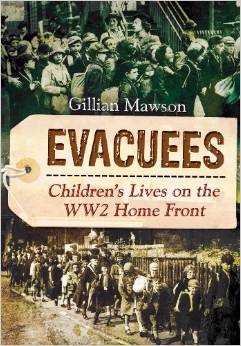It’s not often I read a book in complete silence and am left in such a state of mind after completing it. It was an eye opener, alright. It is funny, informative and poignant but also sad and, at times, disturbing.
Much has been written on evacuees over the years, there have been documentaries, films and even comedies that touch on the subject. But as far as this book is concerned this wraps it all up in one handy and superb package. Mawson has just the right mixture of stories and anecdotes to keep you glued to the pages and this stops you from putting the book down.
In Britain, some three and half million people are said to have been evacuated during the Second World War. Most of this took place between 1939 and 1940. That is some logistical undertaking and as is the case of such large movements of people not everything ran smoothly. A shortage of beds, food, clothes and school places added to an already frayed network and frame of a country at war. The iconic image of a schoolboy in shorts clutching his teddy and wearing a cardboard gas mask case around his neck have gone forever for me after reading this book. I was amazed at how little I actually knew about the plight of Britain’s evacuees. Many lived happy lives; had great memories and stayed in touch with their foster parents years after the war’s end.
Unfortunately many also had bad experiences and were treated harshly and cruelly. Some were forced to work and were starved while others were sexually assaulted.
One simply cannot imagine the fear and pain felt by the children, some babies only months old, some as old as seventeen. Many were evacuated from their mothers (the majority of their fathers were away in the forces) often with a sibling in tow, only to get to their destination to be torn apart once more from their sisters or brothers. It was harsh but it many cases it was necessary.
There are many different views on the whole evacuee process during the war but one theme that seems to be agreed upon is that it was an exercise that saved thousands of young lives.They came from London, Glasgow and Cardiff. They came from Guernsey and Jersey and they even came from Gibraltar. Most were sent to so-called ‘quiet sectors’ often the countryside. Devon, Dorset or Hertfordshire. Some however were sent out of the frying pan into the fire!
In hindsight it would be easy to criticise such decisions and reevaluate the whole programme, but as Mawson explains through her chosen stories, Operation Pied Piper was dropped on an already war weary country’s lap. The fact the system in general worked like clockwork and, for the majority of Britain’s children they were spared the horrors of war; is a testament to the dedication and planning of a select few. The majority were housed and fed and loved by people who started off as strangers and ended as family is testament to the thousands of foster parents who took it upon themselves to take those less fortunate than themselves into their homes.
It’s a very British story and it’s one that makes you proud. For this I have to thank Gillian Mawson and all those evacuees who shared their experiences. A saved generation HAS to be worth reading about. Without them how many of us would be here today?
EVACUEES
Children’s Lives on the WW2 Home Front.
By Gillian Mawson.
Pen & Sword
ISBN: 978-1783831531
